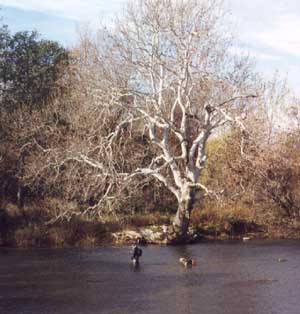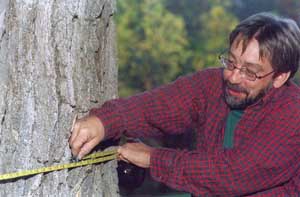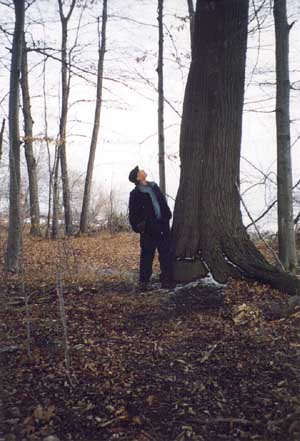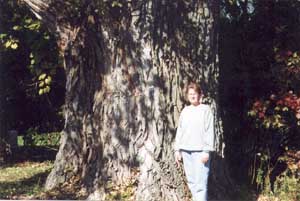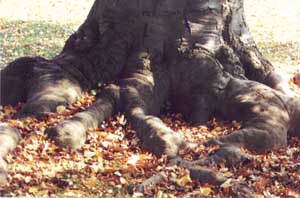
Somewhere out there, in a front yard, along a highway, deep in the forest, or growing in a public park is a big, old, or unusual tree that scientists want to know about. Maybe that big tree that only you have noticed is a potential national champion destined to be cloned as part of the Washington, D.C.-based organization, American Forests. The program is searching America for record breaking tree specimens. One of the biggest, if not the biggest tree, in our area is a magnificent Poplar that stands in Hamlin at the north end of Redman Road in front of the Country Corner Bed and Breakfast, owned and operated by Linda DeRue and her husband, John. The 65-foot tall, 22-feet in circumference, 7.5 foot in diameter Poplar tree is thought to be at least 150-years old. It guards the entrance to property previously owned by five generations of the Austin family, successful Hamlin fruit growers, whose 150 acres of apple and cherry orchards annually produced tons of fruit for over a century. Another Hamlin tree, identified as a Bigtooth Aspen (a close relative of the native Poplar), once actually made the record books. According to Hamlin resident Ed Evans, the 1976 World Almanac listed the 93-foot giant in the Giant Trees of the United States. Unfortunately, it was destroyed by lightning and removed several years ago. Evans, who was instrumental in protecting Yanty Creek March along Lake Ontario in Hamlin, is especially fond of the huge Black Oak tree rescued from destruction by the recent creation of a break wall that protects the marsh from the lake's deadly high water levels. The tree stands not far from the Yanty Creek Nature Trail where visiting school children have dubbed it "Grandpa." According to Rick Lair, a landscape architect and Director of Facilities Maintenance at SUNY Brockport, "Grandpa," about 60-feet tall, is 100 years old, or older, and a prime example of old growth trees native to upstate western New York. Black Oak trees were once far more widespread in our region. Many have been cut for timber or used in furniture making. The bark is used to make tannin, used to cure leather, and for a common yellow dye used in the textile industry. Lair oversees the care of trees on the SUNY Brockport campus - the closest thing to an arboretum we have in western Monroe and eastern Orleans counties. The front lawn of Hartwell Hall, the oldest part of the campus, hosts several unusual trees seldom seen in our region. Among the rarest is a Spanish Chestnut tree situated between Hartwell Hall and the former college president's residence, now known as Alumni House. In the fall, smallish spiked fruit, similar to the more common Horse Chestnuts fall from the tree and are edible. (The Horse Chestnut tree, a popular ornamental species, is not native to North America. It was imported from Europe in 1746 by the famed nurseryman and naturalist John Bartram.) Protected from the harshest winter weather by the Hartwell building is a Magnolia Soluligeana seldom seen this far north. Rick Lair reckons the Magnolia has only survived because of the protection the proximity of the building provides. A companion tree of the same variety was destroyed in the ice storm of 1991. Not far to the north of the main entrance to Hartwell is a Kentucky Coffee Tree (Gymnocladus dioica), another very unusual tree for this area. It is easily identified by its fruit, a thick, flat pod, containing 4-7 flat broad seeds which were used during colonial times as a coffee substitute. Whatever technique Colonists used to ready the seeds for human consumption are lost to us. But they must have done something right because the Kentucky Coffee Tree seed is now known to be poisonous to sheep, cattle, horses and humans. An excellent example of the Tuliptree stands on the lawn nearby. Also known as the Yellow Poplar (liriodendron tulipifera) these tall, straight trees, with their unique yellow-orange tulip-like spring blossoms, are one of the most beautiful hardwoods of the East. Walt Whitman called it the "Apollo of the woods." A Sycamore (Platanus occidentalis), also known as the American Planetree, stands near the walk leading to Monroe Avenue and Utica Street. The Sycamore is known to have the largest trunk of any North American hardwood; the current champion has an 11-foot diameter. This tree is famous for its greenish-brown and white peeling bark. (Another beautiful Sycamore, almost white, stands on the upstream side of Sandy Creek at the east fork bridge in Hamlin.) In the middle of Hartwell's lawn is another unusual planting, a Weeping Mulberry tree (Morus alba pendule) - a small shrub-like tree about 12 feet tall, with cascading, arching branches sweeping the lawn. Down the walk leading to College Street in Brockport, several magnificent Silver Maples line the way. Their burly gnarled roots threaten the stability of the sidewalk, one of the reasons Silver Maples are so frequently maligned by landscapers as "trash trees." Silver Maples are fast growing, and short-lived so unless sited carefully and well maintained they can present problems for the homeowner. But the stature and character of these trees is undisputedly magnificent. Several other near-champion large Silver Maples can be seen at the site of the Old Grammar School, now the Utica Street Playground. Old photos showing the school building before it was demolished in the 1950s also show the trees still standing today. Also, a single, stout Silver Maple stands in the front yard of the Morgan Manning house on Main Street in Brockport. Big Copper Beech trees are common in our area and one fine specimen lives at the Morgan Manning House. Another shades the 1810 Park-Palmer house at 299 Main Street, currently in the care of homeowner Sue Miller. But by far the grandest Copper Beech, one worthy of a special trek to see, stands in Brockport's Lakeview Cemetery on Route 19 just south of the village. The tree stands in the lower, northern, part of the cemetery known as section B, overlooking the pond. Todd Swan, Lakeview's resident caretaker, says arborists who tend the cemetery's trees estimate it to be over 150 years old, predating the 1891 creation of the cemetery. Near the Copper Beech is a tall Dawn Redwood, also known as a Metasequoia. Native to Szechuan, China, the Metasequoia species was unknown to botanists until it was first discovered in 1945. The first seeds were imported by Boston's Arnold Arboretum in 1948 and selectively distributed around the country. Unfortunately Lakeview Cemetery has no records to explain how its rare, prize specimen of this unusual tree came to be planted in Brockport. Judging from its height and girth, it's about 50 years old so it must have been sown from one of the first seeds reaching America. Elsewhere in Lakeview Cemetery are some monumental Hemlock and White Spruce trees - centenarians at least. The White Spruce, along with the Black Spruce, its close cousin and frequent companion, often reaches 100 feet high at maturity. Before the arrival of Europeans, vast stands of these trees stretched across upstate New York. The density and ubiquity of upstate coniferous and hardwood forests caused early settlers to refer to the region as "The Black North." When it comes to judging champion trees it's the organization American Forests in Washington, D.C. that decides which tree gets crowned. They have precise rules about how to measure a tree's height, circumference and crown width. They use a mathematical formula to transpose a tree's characteristics into a numerical score. Some champion trees are then cloned and grown into seedlings or grafted onto rootstock and given away to communities interested in propagating America's great trees. For the record, a 275-foot-tall Giant Sequoia in California is America's biggest tree, nearly 83-feet in diameter. The country's biggest Christmas tree, a Blue Spruce, grows in Utah and is almost three times as tall as the national Christmas tree displayed at the White House. About 50 national champion trees have been cloned so far, with over 2,000 cloned trees planted in parks and public spaces around the country. Cuttings of the last known apple tree planted by Johnny Appleseed, and offspring of a Tuliptree George Washington planted in 1785 at Mount Vernon, are among the cloned trees being distributed by American Forests and the Champion Tree Project. A recent discovery of an old growth forest on the shoreline of Hemlock Lake attracted international attention to the trees of western New York. One Hemlock was determined to be 515 years old, pre-dating Columbus' discovery of America. One of the ecologists working at the site, Bruce Kershner, of Buffalo, has a book coming out later this year which will include about 20 examples of great trees in Western New York. The book, tentatively titled The Sierra Club Guide to Ancient Forests of the Northeast, will be published by Random House later this year. For information about American Forests, directions on how to measure a tree, how to submit a candidate for consideration as a national champion or to learn more about existing champion trees, or to buy a cloned tree go to www.americanforests.org or e-mail: info@amfor.org. The US Postal Address is American Forests, P.O. Box 2000, Washington, D.C. 20013. The street address is 910 17th Street NW, Suite 600, Washington, D.C. 20006, Telephone: (202) 955-4500. To view photographs of champion trees, learn more about cloning important trees and how individuals and communities have worked together to save and protect champion trees log on to: www.championtrees.org. Let us know. If you have or know about a large, old or special tree, the Suburban News and Hamlin-Clarkson Herald would like to learn more about it. Send a photo and a note telling about the tree. Mail responses to Trees, Westside News Inc., P.O. Box 106, Spencerport, NY 14559. |
